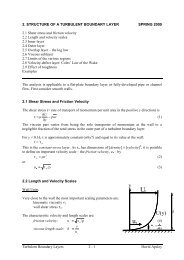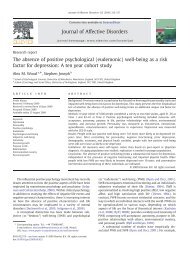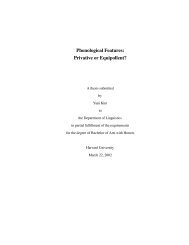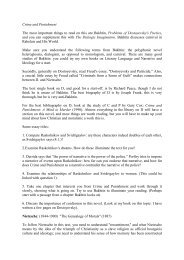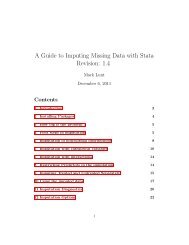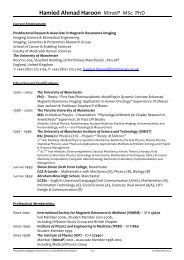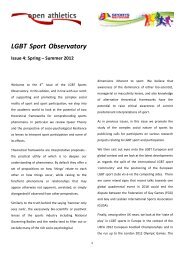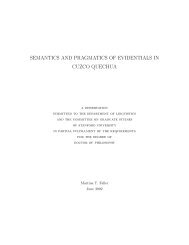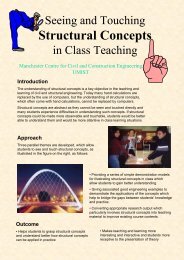Morphology and prosody in Huave phonological domains
Morphology and prosody in Huave phonological domains
Morphology and prosody in Huave phonological domains
Create successful ePaper yourself
Turn your PDF publications into a flip-book with our unique Google optimized e-Paper software.
<strong>Morphology</strong> <strong>and</strong> <strong>prosody</strong> <strong>in</strong> <strong>Huave</strong> <strong>phonological</strong> doma<strong>in</strong>s<br />
Yuni Kim (yuni.kim@manchester.ac.uk)<br />
University of Manchester<br />
CASTL Colloquium, Tromsø * May 6, 2010<br />
(1) <strong>Huave</strong>: a language isolate of Oaxaca State, Mexico. All data here are from fieldwork on the San Francisco<br />
del Mar dialect (
(6) Phonological: With<strong>in</strong> these morphological constra<strong>in</strong>ts, prefixal vs. suffixal realization is conditioned<br />
largely by <strong>phonological</strong> properties of the base to which the affix attaches (Kim, <strong>in</strong> press). Mobile affixes are<br />
suffixes by default, but prefix to V-<strong>in</strong>itial stems if this will avert the need for epenthesis.<br />
Crucial separation of “affix hierarchy” (abstract constituent structure) from “affix placement” (factors<br />
locat<strong>in</strong>g a mobile affix on one or another side of the stem; Stump 1993, Noyer 1997).<br />
(7) Do the <strong>in</strong>dependently motivated morphological constituents co<strong>in</strong>cide with <strong>phonological</strong> doma<strong>in</strong>s?<br />
(8) Outl<strong>in</strong>e of talk<br />
• Motivat<strong>in</strong>g the layer model of <strong>Huave</strong> verb structure<br />
• Phonology that is sensitive to “<strong>in</strong>ner” (Stem, L1) <strong>and</strong> “outer” (L3+) layers<br />
• The stem + suffix doma<strong>in</strong>: phonology that excludes prefixes --> not a morphological constituent<br />
• Is the stem + suffix a Phonological Word? If not, what other options exist?<br />
Hierarchical constituent structure <strong>in</strong> the <strong>Huave</strong> verb<br />
(9) This section: Despite affix mobility, it can be shown that affixes attach <strong>in</strong> a fixed order. The only th<strong>in</strong>g<br />
that varies is which side of the verb the mobile affixes surface on.<br />
(10) In addition to mobile affixes, <strong>Huave</strong> has prefixes <strong>and</strong> suffixes of the normal k<strong>in</strong>d.<br />
a. Future (FUT) i- i-m-a-rang ‘s/he will do (it)’<br />
FUT-SUB-TV-do<br />
b. “Reflexive” (RFL) -e a-rang-e ‘s/he does (it) for self’<br />
TV-do-RFL<br />
c. 1 st & 2 nd plural (PL) -n i-rang-an ‘you (pl.) do (it)’<br />
2-do-PL<br />
(11) Two k<strong>in</strong>ds of stems<br />
• “Prefix<strong>in</strong>g” (default, all trans. & some <strong>in</strong>trans.) - form stems with a valence-related theme vowel (TV)<br />
• “Suffix<strong>in</strong>g” (rema<strong>in</strong><strong>in</strong>g <strong>in</strong>transitives) - if C-f<strong>in</strong>al, form stems with a suffix vowel (V) of predicatble<br />
harmonic quality <strong>and</strong> debatable morphological status<br />
• (Terms are based on placement of earliest-attach<strong>in</strong>g mobile affixes, <strong>and</strong> do not mean that a stem<br />
conditions only one or the other type of affix placement)<br />
Prefix<strong>in</strong>g stems Suffix<strong>in</strong>g stems<br />
a. a-jaw ‘see, know (it)’ d. mojk-o ‘lie face down’<br />
TV-see<br />
face.down-V<br />
b. a-chiot ‘break (it)’ e. chiot-a ‘break’, itr.<br />
TV-break<br />
break-V<br />
c. u-ndiak ‘speak’, itr. f. tye- ‘hang’, itr.<br />
TV-speak<br />
hang<br />
(12) “Layers” <strong>in</strong> <strong>Huave</strong> verb structure: alternat<strong>in</strong>g zones of mobile <strong>and</strong> non-mobile affixes. Mobile affixes<br />
are found <strong>in</strong> Layers 1 <strong>and</strong> 3. Layer 2 consists of prefixes/suffixes occurr<strong>in</strong>g between Layers 1 <strong>and</strong> 3, <strong>and</strong> Layer 4<br />
consists of prefixes/suffixes outside Layer 3. With<strong>in</strong> each layer there is still a fixed order of attachment.<br />
[L4 [L3 [L2 [L1 [Stem] L1] L2] L3] L4]<br />
| | | | | | | |<br />
Prefix Mobile Prefix Mobile Mobile Suffix Mobile Suffix<br />
(13) Constituent structure is not obvious when affixes are on opposite sides of the root.<br />
t a rang as OR t a rang as ?<br />
CPL-TV-do-1 CPL-TV-do-1<br />
But relative order<strong>in</strong>g is observable when two mobile affixes are on the same side of the root.<br />
2
(14) 2 nd -<strong>in</strong>transitive -r- (2I) is <strong>in</strong>side (closer to the root than) 2 nd person & everyth<strong>in</strong>g outside that<br />
a. Nonapparent: m-e-wit-ior ‘that you (sg.) get up’ t-e-wit-ior ‘you (sg.) got up’<br />
SUB-2-rise-2I CPL-2-rise-2I<br />
b. More apparent: m-e-r-u-ty ‘that you (sg.) eat’ t-e-r-u-ty ‘you (sg.) ate’<br />
SUB-2-2I-TV-eat CPL-2-2I-TV-eat<br />
(15) Completive -t- <strong>and</strong> 1 st -subord<strong>in</strong>ate -n- are <strong>in</strong>side first-person -s-/-x-:<br />
a. Nonapparent: t-a-rang-as ‘I did (it)’ x-i-wit-io-n ‘I will get up’<br />
CPL-TV-do-1 1-FUT-rise-V-1SB<br />
b. More apparent: wit-io-t-u-s ‘I got up’ x-i-n-a-rang ‘I will do (it)’<br />
rise-V-CPL-ITR-1 1-FUT-1SB-TV-do<br />
c. And: ndil-i-t-ey-as ‘I turned my head’ ndil-i-n-ey-as ‘that I turn my head’<br />
turn-V-CPL-RFL-1 turn-V-1SB-RFL-1<br />
(16) Note <strong>in</strong> (14b) that first-person -s- is outside FUT on the prefix side...<br />
... while <strong>in</strong> (14c), it is outside RFL on the suffix side. Verb structure, schematically:<br />
[ s FUT ..... STEM .... RFL s ]<br />
L3 L2 L1 L1 L2 L3<br />
(17) Strategy: use the “fixed po<strong>in</strong>ts” FUT <strong>and</strong> RFL to divide the verb <strong>in</strong>to zones, <strong>and</strong> group affixes.<br />
a. Layer 1 - affixes that are <strong>in</strong>side FUT <strong>and</strong> RFL<br />
b. Layer 2 - fixed po<strong>in</strong>ts FUT <strong>and</strong> RFL<br />
c. Layer 3 - affixes that are outside FUT <strong>and</strong> RFL<br />
(18) Justify<strong>in</strong>g Layer 1: All mobile affixes that are <strong>in</strong>side FUT when prefixal are also <strong>in</strong>side RFL when<br />
suffixal. CPL -t- <strong>and</strong> FUT never cooccur, but we <strong>in</strong>fer Layer 1 as CPL is <strong>in</strong>side RFL (17g).<br />
[L3 [L2 [L1 [Stem] L1] L2] L3]<br />
a. x i n a-uñ e ‘I will go shopp<strong>in</strong>g’<br />
1 FUT 1SB TV-buy RFL<br />
b. x i ndil -i n e ‘I will turn around’<br />
1 FUT turn 1SB RFL<br />
c. i m a-uñ e ‘s/he will buy (it) for self)<br />
FUT SUB TV-buy RFL<br />
d. i ndil -i m e ‘s/he will turn around’<br />
FUT turn SUB RFL<br />
e. i m-e-r u-ty ‘you (sg.) will eat’<br />
FUT SUB-2-2I-TV-eat<br />
f. i m-e ndil -i r e ‘you (sg.) will turn around’<br />
FUT SUB-2 turn 2I RFL<br />
g. ndil -i t ey as ‘I turned around’<br />
turn CPL RFL 1<br />
3
(19) Layer 3 consists just of the mobile 1 st Person affix -s-. It occurs outside all L1 <strong>and</strong> L2 affixes.<br />
Even where it does not cooccur with other affixes, we can now diagnose it as occupy<strong>in</strong>g an outer<br />
morphological slot.<br />
[L3 [L2 [L1 [Stem] L1] L2] L3]<br />
a. x- [i- n- a-jch] ‘I will give (it)’<br />
1 FUT 1SUB TV-give<br />
b. s- [a-jch] ‘I give (it)’<br />
1 TV-give<br />
c. x- [i- chut-u -n] ‘I will sit’<br />
1 FUT sit-V 1SUB<br />
d. [t- a-jch] -ius ‘I gave (it)’<br />
CPL TV-give 1<br />
e. [t- a- xot -ey] as ‘I hid myself’<br />
CPL TV-hide RFL 1<br />
(20) Layer 4 conta<strong>in</strong>s the non-cooccurr<strong>in</strong>g plural-mark<strong>in</strong>g suffixes...<br />
o -n (default)<br />
o -f/-w/-h/-Ø (3 rd person; allomorphs due to productive <strong>phonological</strong> rules)<br />
o -r <strong>and</strong> -ts (1 st <strong>in</strong>clusive, <strong>in</strong>terchangeable)<br />
... plus the progressive (PROG) prefix ndyu-/dyu- (phonetically variable prenasalization)<br />
(21) [L4 [L3 [L2 [L1 [Stem] L1] L2] L3] L4]<br />
a. [t- a-ndiak -as] -an ‘We (excl) spoke’<br />
CPL TV-speak 1 PL<br />
b. [t- a-xum -us] -uØ ‘I found them’<br />
CPL TV-f<strong>in</strong>d 1 3PL<br />
c. [i- m- a-jaw -ey] -ar ‘We’ll see e.o.’<br />
FUT SUB TV-see RFL INCL<br />
d. dyu- s- a-t -ion ‘We (excl) are eat<strong>in</strong>g’<br />
PROG 1 TV-eat PL<br />
(22) Summary: Affixes occur <strong>in</strong> strict layer-order; distance from the root is morphologically specified.<br />
L0 1 L1 L2 L3 L4(a/b)<br />
Prefixes -- i-/e- 2 i- FUT -- ndyu- PROG<br />
Suffixes -(j)ch CAUS [+rd] ITR -e RFL -- -rVn PASS -n PL<br />
-f 3PL<br />
-r INC<br />
Mobile -- t CPL<br />
m SB<br />
n 1SB<br />
n ST<br />
r 2I<br />
-- s 1 --<br />
4<br />
-(j)ts INC<br />
(23) Semantic or other pr<strong>in</strong>ciples beh<strong>in</strong>d the morphologically specified order await future research. But<br />
several aspects seem problematic for scopal or mirror-pr<strong>in</strong>ciple approaches, for example:<br />
o 2 nd person <strong>in</strong> Layer 1 but 1 st person <strong>in</strong> Layer 3<br />
o 2 nd person <strong>in</strong>flection <strong>in</strong> Layer 1 but Reflexive derivation <strong>in</strong> Layer 2<br />
1 The number<strong>in</strong>g of the first layer as “0” <strong>in</strong>dicates the nonproductive status of the causative/transitiviz<strong>in</strong>g affix.
Morphologically conditioned phonology<br />
(24) Vowel epenthesis with consonantal suffixes is common, s<strong>in</strong>ce consonant clusters are not allowed.<br />
Epenthesis after V-f<strong>in</strong>al roots: never with Layer 1 suffixes, always with Layer 3 <strong>and</strong> 4 suffixes<br />
(25) L1 L3<br />
a. tye-m b. *tye-am c. t-a-tyey-as d. *t-a-tye-s<br />
hang-SUB CPL-TV-hang-1<br />
Stem-L1 L1-Stem-L3<br />
‘that it hangs’<br />
L1 L4<br />
e. rra-t f. *rra-at g. a-sa-af h. *a-sa-f<br />
dawn-CPL TV-tell-3PL<br />
Stem-L1 Stem-L4<br />
‘It dawned’ ‘they say, tell’<br />
(26) Overapplication of diphthongization: variably with L3/L4 suffixes, (almost) never with L1 suffixes.<br />
(27) Basic consonant <strong>in</strong>ventory:<br />
Labial Coronal Velar Labiovelar Glottal<br />
Stops p mb t nd k ng[ŋg] kw ngw[ŋgw]<br />
Affricates ts nts<br />
Fricatives f[ ] s h<br />
Nasals m<br />
n<br />
Liquids l r[ ] rr[r]<br />
Glides w j<br />
(28) All consonants come <strong>in</strong> pla<strong>in</strong> <strong>and</strong> palatalized versions (/C bk /, /C pal /)<br />
• Palatalization as secondary/abstract (no POA change): All non-coronals <strong>and</strong> rhotics<br />
• Palatalization <strong>in</strong> <strong>in</strong>herent place: Non-rhotic coronals<br />
Pla<strong>in</strong> t nd l ts nts s n<br />
Palatal ty [c] ndy [ ] ly [ ] ch [ ] nch [ ] x [ , ] ñ [ ]<br />
(29) Surface vowels: monophthongs [i e a o u] <strong>and</strong> diphthongs (from underly<strong>in</strong>g monophthongs)<br />
Diphthongs are observed where VC]σ conflict <strong>in</strong> frontness/backness; the frontness/backness of the coda<br />
consonant is realized on the second half of the vowel nucleus.<br />
Front monophthongs [i e] Ris<strong>in</strong>g diphthongs io [jəә, jo] <strong>and</strong> ia [ja]<br />
a. /xix/ xix 'mosquito' c. /mik bk / miok 'bat'<br />
b. /pek pal / pek 'shoulder’ d. /pets bk / piats 'tortilla'<br />
Central/Back monophthongs [a o u] Fall<strong>in</strong>g diphthongs ai oi ui [aj oj uj]<br />
e. /pang bk / pang 'chair' h. /-lak pal / u-laik 'his/her tooth'<br />
f. /ndok bk / ndok 'fish<strong>in</strong>g net' i. /-long pal / a-lo<strong>in</strong>g 'hang, 3sg.'<br />
g. /xur bk / xur 'pot' j. /puk pal / puik 'feather; fur'<br />
(30) S<strong>in</strong>ce <strong>Huave</strong> disallows consonant clusters (e.g. *CVCCVC), codas only occur word-f<strong>in</strong>ally.<br />
Normally when suffixes are added, coda-C front/back features can be realized on a follow<strong>in</strong>g vowel,<br />
the underly<strong>in</strong>g monophthong surfaces.<br />
a. /i-lak pal / i-laik ‘your tooth’ b. /i-lak pal -<strong>in</strong>/ i-lak-ion ‘your (pl.) teeth’<br />
2-tooth 2-tooth-PL<br />
c. /a-jir bk / a-jior ‘has’ d. /a-jir bk -af/ a-jir-af ‘they have’<br />
TV-have TV-have-3PL<br />
5
(31) Optional overapplication:<br />
a. /t-a-lang pal -is/ t-a-la<strong>in</strong>g-ius ~ t-a-lang-ius<br />
CP-TV-cross-1 CP-TV-cross-1<br />
‘I crossed (the road)’<br />
b. /t-a-chit-as/ t-a-chiot-as ~ t-a-chit-as<br />
CP-TV-break-1 CP-TV-break-1<br />
‘I broke (it)’<br />
c. /t-a-jimb pal -is-an/ t-a-jimb-ios-an ~ t-a-jimb-is-an<br />
CP-TV-sweep-1-PL CP-TV-sweep-1-PL<br />
‘We (excl.) swept’<br />
(32) Can be seen as a cyclic effect: the environment obta<strong>in</strong>s at <strong>in</strong>ner levels (Stem/L1, L3).<br />
At each level, there is an option to apply diphthongization, if the conditions are met; variation arises<br />
from whether diphthongization applies “earlier,” or at the level of the whole word.<br />
Root UR Stem L1 L3 L4 Post-cyclic/Word level<br />
a. /-lang pal / a-la(i)ng t-a-la(i)ng t-a-la(i)ng-i(u)s -- t-a-la(i)ng-ius<br />
cross add TV add CPL add 1<br />
b. /-jimb pal / a-jimb t-a-jimb t-a-jimb-i(o)s t-a-jimb-i(o)s-an t-a-jimb-i(o)s-an<br />
sweep add TV add CPL add 1 add PL<br />
Such variation <strong>in</strong> application doma<strong>in</strong> is predicted by the natural diachronic “life cycle” of<br />
phonolological processes (see e.g. Zec 1993).<br />
(33) Diphthongization never(?) overapplies <strong>in</strong> suffix<strong>in</strong>g stems: even at stem level, conditions are not met.<br />
However, there is the possibility for diphthongization at other pre-word levels.<br />
(More data needed to confirm exactly how “bad” diphthongization is <strong>in</strong> this environment.)<br />
Root UR Stem L1 Post-cyclic/Word level<br />
a. /chup pal / chup-i chup-i(o)-m chup-io-m */? chuip-io-m<br />
fill up add V add SUB<br />
(34) Summary: Vowel epenthesis <strong>and</strong> diphthongization show that phonology can be sensitive to<br />
morphological constituency; <strong>in</strong>dependently established morphological doma<strong>in</strong>s also seem to be referred to<br />
<strong>in</strong> morpho<strong>phonological</strong> processes.<br />
The Stem + Suffix Doma<strong>in</strong><br />
(35) The processes discussed until now have only obta<strong>in</strong>ed <strong>in</strong> suffixal contexts, but their application cannot<br />
really be tested <strong>in</strong> the morphologically correspond<strong>in</strong>g prefixal doma<strong>in</strong>s.<br />
• Vowel epenthesis: not attested with prefixes (though San Mateo del Mar dialect may have this)<br />
• Diphthongization: no C-f<strong>in</strong>al prefixes, so no possibility for word-medial coda consonants<br />
(36) Two additional <strong>phonological</strong> processes show a more dramatic limitation to the stem + suffix doma<strong>in</strong>,<br />
where prefixes clearly provide the <strong>phonological</strong> environment - which however is ignored.<br />
(37) Vowel harmony: basic pattern<br />
Base -VC Epenthetic V Base -VC Epenthetic V<br />
iC bk a iC pal i<br />
eC bk a eC pal e<br />
aC bk a aC pal i<br />
oC bk o oC pal i<br />
uC bk u uC pal i<br />
6
(38) Generalizations:<br />
a. Epenthetic V always matches the <strong>in</strong>terven<strong>in</strong>g C for [±back] – phonotactically driven<br />
b. Preced<strong>in</strong>g vowel matters (=is copied) only if it also matches the <strong>in</strong>terven<strong>in</strong>g consonant for [±back]<br />
c. Otherwise, default epenthetic vowel is /a/ after C, <strong>and</strong> /i/ after C’.<br />
“Sour grapes” (Padgett 1995): If you can’t copy, due to the phonotactics of [±back], pretend like you never<br />
wanted to propagate any features <strong>in</strong> the first place. Insert default vowel.<br />
(39) Vowel harmony illustrations: Epenthetic vowel quality (1 st person completive forms: tcpl-atv-ROOT-Vs1)<br />
CVC root (Pla<strong>in</strong> C2) CVC’ root (Palatalized C2)<br />
i a. |t-a-mit-as| ‘I buried (it)’ f. |t-a-xijp pal -is| ‘I bathed (it)’<br />
e b. |t-a-ndek-as| ‘I spoke (it)’ g. |t-a-rrejk pal -es| ‘I touched (it)’<br />
u c. |t-a-mut-us| ‘I wrote (it)’ h. |t-a-un pal -is| ‘I bought (it)’<br />
o d. |t-a-ndok-os| ‘I fished (it)’ i. |t-a-kots pal -is| ‘I scratched (it)’<br />
a e. |t-a-pal-as| ‘I closed (it)’ j. |t-a-kal pal -is| ‘I entered’<br />
(40) So: epenthetic vowel quality depends on the preced<strong>in</strong>g VC sequence.<br />
However, <strong>in</strong> the case of s<strong>in</strong>gle-consonant roots, the preced<strong>in</strong>g V-C will span a prefix-root boundary.<br />
2 nd person plural forms (abstract<strong>in</strong>g away from diphthongization):<br />
a. /mb bk / ‘go’ t-e-mb-an Expected default [bk] after VfrontC bk<br />
CPL-2-go-PL<br />
b. /jts pal / ‘give’ m-e-jch-<strong>in</strong> *m-e-jch-en<br />
SUB-2-give-PL<br />
c. /w pal / ‘borrow’ t-e-w-<strong>in</strong> *t-e-w-en<br />
CPL-2-borrow-PL<br />
(41) In (40bc), default front vowels are <strong>in</strong>serted, even though the environment for full vowel copy is met.<br />
It appears that vowel harmony cannot see leftward past the root.<br />
(42) Laryngeal dissimilation: the second of two [+spread glottis] with<strong>in</strong> a one-syllable w<strong>in</strong>dow is deleted.<br />
All voiceless fricatives are [+spread glottis]: j [h], s, x [ɕ], f [ɸ]<br />
In these examples, passive alternations are produced by add<strong>in</strong>g pre-root aspiration <strong>and</strong> depalatalizat<strong>in</strong>g<br />
the root coda. The pre-root aspiration causes a vowel aspiration <strong>in</strong> the root to disappear.<br />
a. a-naijp<br />
TV-sell<br />
‘S/he sells it’<br />
c. a-paj<br />
TV-call<br />
‘S/he calls, yells’<br />
b. a-j.nap<br />
TV-be.sold<br />
‘It is sold’<br />
d. t-a-j.pa<br />
CP-TV-be.called<br />
‘S/he was called’<br />
(43) The follow<strong>in</strong>g examples show how the 3 rd pl. suffix -f loses [+s.g.], but reta<strong>in</strong>s labiality, when<br />
follow<strong>in</strong>g a root with [+s.g.].<br />
a. t-a-kaj-aw<br />
CP-TV-look.for-3PL<br />
‘they looked for (it)’ (3;41)<br />
c. a-j.ch-iow<br />
TV-give-3PL<br />
‘they give’ (1;174)<br />
e. t-a-xijp-iow<br />
CP-TV-bathe-3PL<br />
‘they bathed’ (3;41)<br />
g. u-lajk-aw<br />
POS1-ear-3PL<br />
‘their ears’ (1;173)<br />
b. t-a-kojñ-iow<br />
CP-TV-fold-3PL<br />
‘they folded (it)’ (3;46)<br />
d. mi-kius-aw<br />
POS-dog-3PL<br />
‘their dogs’ (1;173)<br />
f. dyu-m-a-lox-iow<br />
PROG-SB-TV-throw-3PL<br />
‘they are throw<strong>in</strong>g (it)’ (3;42)<br />
h. u-wix-iow<br />
POS1-h<strong>and</strong>-3PL<br />
‘their h<strong>and</strong>s’ (1;173)<br />
7
(44) Sibilants s <strong>and</strong> x trigger, as shown above, but do not undergo dissimilation.<br />
a. t-a-j.tyux b. t-a-najp-ius<br />
CP-TV-rot CP-TV-sell-1<br />
‘it rotted’ ‘I sold it’<br />
c. piaj-u-s d. ty-u-paj-as<br />
lie-ITR-1 CP-TV-yell-1<br />
‘I lie down' ‘I yelled’<br />
(45) However, when s- is a prefix, it never triggers [+s.g.] deletion <strong>in</strong> the root.<br />
This cannot be a simple root-affix asymmetry, s<strong>in</strong>ce suffixal s (L3) triggers dissimilation <strong>in</strong> the 3PL -f.<br />
a. s-a-jch b. s-a-j.mba<br />
1-TV-give 1-TV-break<br />
‘I give it’ ‘I break (it)’<br />
c. t-a-xum-us-uØ<br />
CPL-TV-1-3PL<br />
‘I met them’<br />
(46) Summary: Vowel harmony <strong>and</strong> laryngeal dissimilation cannot see past the stem to prefixes.<br />
Therefore the stem + suffixes constitute some k<strong>in</strong>d of doma<strong>in</strong> for the application of phonology.<br />
Discussion<br />
(47) How does the stem + suffix doma<strong>in</strong> fit with the morphological picture developed earlier?<br />
[L4 [L3 [L2 [L1 [Stem] L1] L2] L3] L4]<br />
It doesn’t: there is no morphological constituent boundary between the prefixes <strong>and</strong> stem.<br />
The <strong>phonological</strong> doma<strong>in</strong> is def<strong>in</strong>ed l<strong>in</strong>early, but morphological constituents are symmetrical <strong>and</strong><br />
hierarchical.<br />
(48) Could the stem + suffixes be a Phonological Word?<br />
Problematic: neither prefixes nor stems always form <strong>in</strong>dependently valid <strong>phonological</strong> units.<br />
a. [s]-[a-jch] b. [m-e]-[jch]<br />
1-TV-give SUB-2-give<br />
L3-Stem L1-L1-Stem<br />
(49) Possibilities: morphological symmetry has a diachronic basis but is synchronically an illusion (i.e.<br />
prefixes are morphologically separate doma<strong>in</strong>); m<strong>in</strong>imality on (48b) is assessed with a prefixal theme vowel<br />
that is later deleted; phonology can see morphology without be<strong>in</strong>g mediated by the Phonological Word.<br />
Acknowledgements<br />
I would like to thank the <strong>Huave</strong> speakers <strong>in</strong> San Francisco del Mar who have patiently <strong>and</strong> generously hosted me <strong>and</strong> helped<br />
me learn about their language. Fieldwork was supported by Richard Diebold’s Salus Mundi Foundation via the <strong>Huave</strong><br />
Language <strong>and</strong> Culture Project grant to Bill Hanks <strong>and</strong> Maurizio Gnerre; the research was also supported by a National<br />
Science Foundation graduate fellowship.<br />
References<br />
Kim, Yuni. 2008. Topics <strong>in</strong> the phonology <strong>and</strong> morphology of San Francisco del Mar <strong>Huave</strong>. PhD dissertation, UC<br />
Berkeley.<br />
Kim, Yuni. In press. Phonological <strong>and</strong> morphological conditions on affix order <strong>in</strong> <strong>Huave</strong>. <strong>Morphology</strong> 20(1).<br />
Noyer, Rolf. 1993. Mobile affixes <strong>in</strong> <strong>Huave</strong>: optimality <strong>and</strong> morphological well-formedness. In E. Duncan, D. Farkas <strong>and</strong> P.<br />
Spaelti, eds., Proceed<strong>in</strong>gs of the Twelfth West Coast Conference on Formal L<strong>in</strong>guistics, 67-82. Stanford: CSLI.<br />
Noyer, Rolf. 1997. Features, positions <strong>and</strong> affixes <strong>in</strong> autonomous morphological structure. New York: Garl<strong>and</strong>.<br />
Stump, Gregory. 1992. Position classes <strong>and</strong> morphological theory. In G. Booij <strong>and</strong> J. van Marle, eds., Yearbook of<br />
<strong>Morphology</strong> 1992, 129-180. Dordrecht: Kluwer.<br />
Zec, Draga. 1993. Rule doma<strong>in</strong>s <strong>and</strong> <strong>phonological</strong> change. In S. Hargus <strong>and</strong> E. Kaisse, eds., Studies <strong>in</strong> Lexical Phonology,<br />
365-405. San Diego, CA: Academic Press.<br />
8






